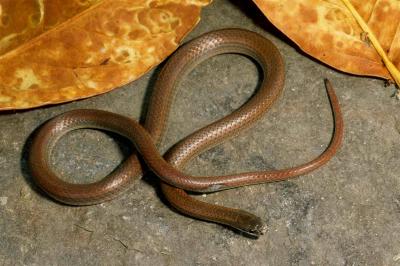We're open daily! View holiday hours
Science News
New Species 2010
December 23, 2010

Global biodiversity surveys over the past few years have provided increasing evidence that our planet is in the midst of its sixth mass extinction. Plants, animals, and microorganisms are disappearing thousands of times more rapidly than they have for more than 65 million years, and for the first time in Earth's history, human activity is the predominant force behind this mass extinction. As governments and conservation organizations around the world attempt to stem this tide of disappearing species, they face a number of formidable challenges, but perhaps the greatest among them is this—we have only documented and described an estimated 10 percent of the species on Earth, and it's hard to save a species when you don't know that it exists.
In an effort to help address this critical need for data about the diversity and distribution of life on our planet, scientists from the California Academy of Sciences have spent the past year exploring some of the most diverse—and often most threatened—habitats on Earth, searching for new species and creating comprehensive biodiversity maps. In 2010, these scientists have added 113 new relatives to our family tree, including 83 arthropods, 20 fishes, four corals, two sea slugs, two plants, one reptile, and one fossil mammal. The new species were described by a dozen scientists from the California Academy of Sciences along with several dozen international collaborators.
Proving that science still requires a spirit of adventure and exploration, the scientists made their finds over five continents (the Americas, Africa, Asia, and Australia) and three oceans (Atlantic, Pacific, and Indian), hiked through rainforests and dove inside submersibles, and looked everywhere from their own backyards (San Mateo County, California) to the other side of the world (the Seychelles). Their results, published in 27 different scientific papers, come during a year of heightened international interest in the conservation of life on Earth. The United Nations designated 2010 as the "International Year of Biodiversity" and held a Biodiversity Summit in Nagoya, Japan this October, in which 18,000 participants representing more than 150 countries adopted strategic goals to combat ongoing biodiversity loss compounded by climate change.
"Species loss has been accelerating in the last 150 years due to human activity, with extinction rates estimated to be thousands of times greater than average," says Dr. David Mindell, Dean of Science and Research Collections at the Academy. "Scientific exploration and discovery of new species are essential to characterizing our planet's ecosystems before they disappear forever. Preserving biodiversity means healthy ecosystems, and healthy ecosystems are crucial to human health and economic well-being."
A recent example of this intimate connection appeared in the December 2nd issue of Nature, in which a team of U.S. and British scientists found that the transmission of infectious diseases, such as West Nile fever and Lyme disease, increased in environments where the diversity of wildlife was low. While the exact mechanisms behind this correlation remain unknown, the study illuminated a real danger to humans that results from biodiversity loss.
Below are a few highlights among the 113 species described by Academy scientists this year. For a full list of species, including geographic information, visit www.calacademy.org/newsroom/releases/2010/new_species_list.php.